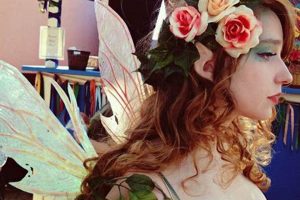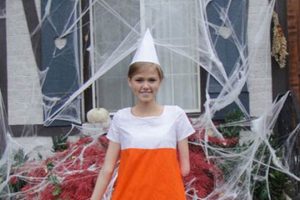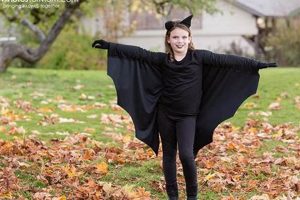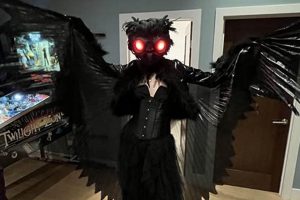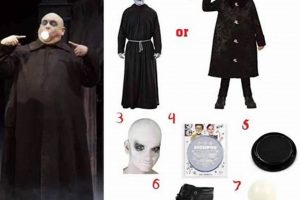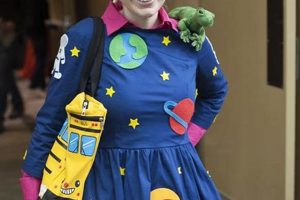Creating a handcrafted representation of the iconic Sailor Moon uniform allows for a personalized expression of fandom. This approach involves constructing each element of the character’s signature attire, from the sailor collar and skirt to the accessories such as gloves, tiara, and boots, using readily available materials and crafting techniques.
The value in undertaking such a project lies in its affordability and customization potential. Pre-made costumes often lack individualized details or may not perfectly fit the wearer. Moreover, crafting one’s own interpretation allows for the use of higher-quality materials, resulting in a durable and unique piece. Historically, fan-made costumes have been a staple of cosplay culture, demonstrating dedication and artistry.
The following sections will detail methods for constructing various components of this project, providing guidance on pattern selection, material choices, and assembly techniques. This enables individuals to create a faithful and distinctive tribute to the beloved character.
Tips for Creating a Handcrafted Sailor Moon Uniform
The following suggestions aim to guide the construction of a durable and visually appealing representation of the character’s attire. Emphasis is placed on material selection, accurate detailing, and structural integrity.
Tip 1: Fabric Selection is Paramount: Prioritize fabrics that possess both visual appeal and durability. Gabardine, twill, or high-quality cotton blends are suitable choices for the main body of the sailor suit. These materials offer a good balance of drape, colorfastness, and resistance to wear and tear.
Tip 2: Prioritize Accurate Color Matching: The iconic nature of the costume demands precision in color selection. Source fabric swatches that closely match the established color palette of the character’s uniform. Discrepancies in color can detract significantly from the overall impact.
Tip 3: Employ Professional Seam Construction Techniques: Reinforce seams using techniques such as topstitching or serging to prevent fraying and ensure long-term durability. High-stress areas, such as the collar and skirt waistband, warrant extra reinforcement.
Tip 4: Accurate Proportions are Critical: Pay close attention to the proportions of the collar, skirt, and bows relative to the wearer’s measurements. Utilize accurate pattern drafting or modification techniques to ensure a flattering and visually balanced silhouette.
Tip 5: Accessories Demand Attention to Detail: The tiara, gloves, and boots contribute significantly to the overall aesthetic. Select high-quality materials for these components and prioritize craftsmanship to create pieces that are both visually striking and structurally sound. Consider using durable craft foam or thermoplastics for the tiara’s construction.
Tip 6: Closures Should be Secure and Discreet: Select closures, such as zippers or snaps, that are both secure and aesthetically integrated into the design. Hidden closures contribute to a cleaner and more professional finish.
Tip 7: Incorporate Interfacing for Structure: Utilize interfacing in areas such as the collar and waistband to provide added structure and prevent sagging. The appropriate weight and type of interfacing should be selected based on the weight and drape of the primary fabric.
Careful attention to these details will result in a handcrafted uniform that is both visually impressive and designed to withstand repeated wear. The result is a unique, durable, and personally tailored garment.
The following section explores specific pattern modifications and construction techniques to enhance the overall accuracy and aesthetic appeal of the handcrafted Sailor Moon uniform.
1. Pattern Accessibility
Pattern accessibility represents a critical factor determining the feasibility and complexity of creating a handcrafted Sailor Moon uniform. The availability, cost, and skill level required to utilize a given pattern directly impact the project’s success and the creator’s experience.
- Free Online Resources
Numerous websites and online communities offer free patterns for various components of the Sailor Moon costume. These resources often cater to beginner crafters, providing basic shapes and instructions. However, the quality and accuracy of free patterns can vary considerably, potentially requiring adjustments and modifications. Their accessibility lowers the barrier to entry, but may demand more improvisation and problem-solving skills.
- Commercial Patterns
Reputable pattern companies sell pre-made patterns specifically designed for cosplay and costume construction. These patterns typically feature detailed instructions, multiple size options, and higher levels of accuracy compared to free resources. While incurring a cost, commercial patterns often save time and effort, particularly for individuals with limited pattern drafting experience. They provide a structured approach and a more predictable outcome.
- Pattern Drafting Skills
Individuals with advanced sewing and pattern drafting skills may opt to create their own patterns from scratch. This approach offers complete customization and allows for precise tailoring to the wearer’s measurements. However, drafting patterns requires a thorough understanding of garment construction principles and can be a time-consuming and challenging endeavor. It is the most specialized and individualized approach.
- Pattern Modification
This involves adapting existing patterns, whether free or commercial, to better suit individual needs or design preferences. It requires a moderate understanding of pattern alteration techniques and can bridge the gap between using ready-made patterns and drafting from scratch. Modifying patterns can correct fit issues, add design details, or simplify complex construction steps, allowing for a more personalized and manageable project.
In conclusion, the choice of pattern source significantly influences the time commitment, skill level required, and overall accuracy of a handcrafted Sailor Moon uniform. Careful consideration of these factors is essential for achieving a satisfactory and enjoyable crafting experience. The availability of varied pattern options allows for tailoring the project to individual skills and available resources, enhancing the overall potential for successful construction.
2. Fabric Selection
Fabric selection constitutes a pivotal determinant in the final aesthetic, durability, and overall success of a handcrafted Sailor Moon uniform. The chosen materials directly impact the visual fidelity to the character’s iconic design, the comfort of the wearer, and the longevity of the garment.
- Color Accuracy and Saturation
The precise shades of blue, white, and red are integral to the character’s visual identity. Opting for fabrics with inaccurate or washed-out colors compromises the recognizability and impact of the costume. Colorfastness is also critical; fabrics that bleed or fade upon washing will diminish the costume’s quality over time. High-quality dyes and pre-treating fabrics can mitigate these risks.
- Drape and Texture
The way a fabric drapes affects the overall silhouette and visual flow of the uniform. Stiff, unyielding fabrics can create an unflattering or unnatural appearance, while fabrics with excessive stretch may distort the intended shape. The texture of the fabric also contributes to the perceived quality; a smooth, polished finish often conveys a more refined and professional aesthetic. Utilizing fabrics with a suitable weight and drape properties ensures a visually appealing and comfortable fit.
- Durability and Maintenance
The rigors of wear, handling, and cleaning necessitate selecting fabrics that can withstand stress and maintain their appearance over time. Fabrics prone to tearing, fraying, or wrinkling will require more frequent repairs and maintenance. Choosing durable, easy-to-care-for materials reduces the long-term upkeep costs and extends the lifespan of the costume. Considering factors such as washability, stain resistance, and wrinkle resistance is paramount.
- Comfort and Breathability
While aesthetic considerations are important, prioritizing comfort is crucial for extended wear. Fabrics that trap heat and moisture can lead to discomfort and overheating. Selecting breathable, natural fibers or moisture-wicking synthetic blends enhances comfort and allows for prolonged use, particularly in warm environments or during active events. Prioritizing comfort improves the overall wearing experience and encourages more frequent use.
In summary, fabric selection represents a multi-faceted decision process that significantly influences the quality and satisfaction derived from a handcrafted Sailor Moon uniform. By carefully considering color accuracy, drape, durability, and comfort, the creator ensures a visually appealing, long-lasting, and enjoyable final product. Neglecting these factors can result in a substandard costume that fails to meet expectations or withstand the demands of repeated wear.
3. Color Accuracy
The faithfulness of color representation is paramount in the construction of a handcrafted Sailor Moon uniform. Accurate colors are essential for immediate recognition and convey the character’s established visual identity. Deviations from the canonical color palette compromise the overall aesthetic and impact the costume’s success.
- Sailor Collar and Skirt Hue
The specific shade of blue used for the sailor collar and skirt is a defining characteristic of the costume. Inaccurate blue tones, such as those that are too light, too dark, or leaning towards green or purple, detract significantly from the overall authenticity. Matching the fabric to established color references, such as official character artwork or cosplay guides, is crucial. For instance, using a royal blue instead of a more accurate, slightly muted navy blue would be a noticeable discrepancy.
- Bow and Ribbon Saturation
The vibrant red or pink hues used for the bows and ribbons demand careful consideration. Faded or dull colors diminish the costume’s visual appeal and can make it appear aged or poorly maintained. Sourcing fabrics with high color saturation and ensuring their colorfastness are essential. A common error is using a light pink instead of a vivid magenta for certain iterations of the costume.
- White Fabric Purity
The crispness and brightness of the white fabric used for the bodysuit and other components contribute to the overall clean and polished look of the costume. Off-white or dingy fabrics can create a sense of age or neglect. Selecting a pure white fabric and maintaining its cleanliness throughout the construction process is vital. A noticeable example is using a cream-colored fabric which can make the other colors appear off.
- Accessory Color Consistency
Maintaining consistent color across all elements, including the tiara, gloves, and boots, is important for visual harmony. Discrepancies in color between these accessories and the main uniform can disrupt the overall aesthetic. Careful matching of colors across different materials and textures is necessary. As an example, ensure the red of the boots closely matches the red of the bows.
The successful creation of a handcrafted Sailor Moon uniform hinges significantly on achieving accurate color representation. By prioritizing fabric selection, dye quality, and meticulous color matching, the creator can produce a visually compelling and authentic representation of the character. Attention to detail in color accuracy elevates the costume from a simple garment to a faithful tribute to the iconic Sailor Moon design.
4. Construction Durability
The longevity and resilience of a handcrafted Sailor Moon uniform are directly proportional to the construction techniques employed. Attention to structural integrity is paramount, ensuring the garment withstands repeated wear, handling, and potential cleaning cycles. Inadequate construction methods lead to premature degradation, diminishing the costume’s value and lifespan.
- Seam Reinforcement
Weakly constructed seams represent a common failure point in homemade garments. Reinforcing seams through techniques such as topstitching, serging, or employing durable seam finishes is crucial. High-stress areas, including the waistband, collar, and armholes, necessitate additional reinforcement. An example includes a Sailor Moon skirt where the zipper pulls away from the fabric after a few wears due to insufficient seam reinforcement.
- Fabric Stabilization
Using interfacing or lining fabrics can significantly enhance the structural stability of certain components, particularly collars, cuffs, and bodices. These additions prevent stretching, sagging, and wrinkling, maintaining the garment’s intended shape and appearance. A non-interfaced collar, for instance, may lose its crisp shape and become limp after minimal use.
- Closure Integrity
The selection and attachment of closures, such as zippers, snaps, and buttons, must be robust to prevent failure during wear. Reinforcing the fabric around closures and using high-quality hardware ensures secure fastening and minimizes the risk of breakage. A poorly attached zipper is a common issue, potentially leading to garment malfunction during an event or performance.
- Material Selection Alignment
The durability of the chosen fabric must be consistent with the intended use of the garment. Delicate fabrics, while visually appealing, may not withstand the rigors of cosplay or frequent wear. Selecting durable, easily maintained materials, such as gabardine or twill, promotes longevity and reduces the need for repairs. Silk, while beautiful, is less durable than cotton twill in high-stress areas.
By prioritizing robust construction techniques and selecting durable materials, the creator ensur
es that a handcrafted Sailor Moon uniform not only captures the aesthetic essence of the character but also withstands the demands of repeated use. A well-constructed costume represents a worthwhile investment of time and resources, providing long-term enjoyment and minimizing the need for costly repairs or replacements.
5. Accessory Detail
The meticulous incorporation of precise accessory details elevates a handcrafted Sailor Moon uniform from a simple garment to a faithful representation of the character. These elements, while seemingly minor, contribute significantly to the overall aesthetic and recognizability of the costume.
- The Tiara’s Geometric Accuracy
The tiara’s shape, material, and jewel placement are critical. An inaccurate tiara diminishes the overall effect. Using a template with correct dimensions and selecting a metallic material, such as craft foam treated to resemble metal, achieves the required look. A deviation from the tiara’s proper crescent moon shape is easily noticeable, undermining the intended effect.
- The Choker’s Proper Placement and Material
The choker, a seemingly simple element, must sit correctly on the neck and utilize a material that accurately reflects its texture. A choker that is too loose, too tight, or constructed from an inappropriate material detracts from the costume. Velvet or a similar fabric offers the appropriate texture and appearance.
- Glove Construction and Length
The gloves’ length and construction are crucial. The gloves must fit snugly and extend to the correct point on the arm. Ill-fitting or improperly sized gloves disrupt the costume’s silhouette. Using stretch fabric allows for a snug fit, and precise measurements ensure the appropriate length.
- Boot Style and Color Consistency
The boots must match the color of the skirt and possess the correct shape and height. Discrepancies in color or style are readily apparent. Utilizing boot covers made from the same fabric as the skirt ensures color consistency. The boot shape should also mirror the character’s footwear style.
In summation, careful attention to these accessory details distinguishes a high-quality, handcrafted Sailor Moon uniform. The accuracy and precision of each accessory contribute significantly to the overall visual impact and authenticity of the costume. Neglecting these elements can result in a less compelling or recognizable representation of the character. The culmination of these details transforms a basic outfit into an accurate homage.
6. Fit Customization
Achieving a proper fit is critical when constructing a handcrafted Sailor Moon uniform. As ready-to-wear sizes often fail to accommodate individual body shapes accurately, customizing the fit ensures both comfort and aesthetic fidelity to the character’s depiction.
- Pattern Grading and Alteration
Modifying a pre-existing pattern, or drafting one from scratch, allows for adjustments to key measurements such as bust, waist, and hip circumference. This ensures the bodice conforms accurately to the wearer’s torso, avoiding gapping or constricting. For example, adjusting the dart placement on the bodice pattern accommodates varying bust sizes, creating a smooth and flattering silhouette. Ignoring this leads to a poorly fitting bodice, detracting from the overall costume.
- Skirt Length and Proportion Adjustments
Adjusting the skirt length is crucial for maintaining proper proportions and reflecting the wearer’s height. Shortening or lengthening the skirt ensures it falls at a flattering point on the leg. Failing to consider individual height when determining skirt length can result in an unflattering or imbalanced appearance.
- Sleeve and Glove Sizing
Altering sleeve patterns or modifying glove construction accounts for arm length and hand circumference. Ensuring sleeves and gloves fit snugly without restricting movement is essential for comfort and visual appeal. Adjustments prevent sleeves from being too short or gloves from being too tight, both of which detract from the overall aesthetic.
- Bodysuit Customization for Torso Length
A one-piece bodysuit requires careful consideration of torso length. Adjusting the pattern vertically ensures the bodysuit fits comfortably without pulling at the shoulders or causing excess fabric to bunch at the crotch. This adjustment is critical for freedom of movement and a smooth, streamlined appearance.
The process of crafting a Sailor Moon uniform offers a unique opportunity to create a garment that fits the wearer perfectly. Prioritizing proper fit through careful measurements and pattern adjustments significantly enhances the overall appearance, comfort, and wearability of the final product.
7. Budget Management
Effective resource allocation constitutes a crucial component in the successful creation of a handcrafted Sailor Moon uniform. The ability to adhere to a predetermined financial framework dictates the quality of materials acquired, the complexity of construction techniques employed, and the feasibility of completing the project within a reasonable timeframe.
- Material Sourcing Strategies
Acquiring fabrics, trims, and accessories represents a significant expenditure. Prudent sourcing involves comparing prices from multiple vendors, exploring discount options such as remnant sales or online marketplaces, and considering the cost-effectiveness of alternative materials. For example, substituting a less expensive, but visually similar, fabric for a high-end textile can significantly reduce overall expenses without drastically compromising the final aesthetic. Furthermore, repurposing existing materials from old garments or household items can contribute to cost savings.
- Pattern Selection and Modification
The choice between purchasing a commercially available pattern and utilizing a free online resource directly impacts the budget. While commercial patterns offer detailed instructions and potentially a more accurate fit, they incur a cost. Free patterns may require more time and effort for modifications and adjustments. Skilled crafters may opt to draft their own patterns, eliminating pattern costs altogether but demanding greater expertise and time investment. The economic value of one’s time should also be considered when selecting pattern options.
- Tool and Equipment Considerations
Sewing machines, specialized tools, and notions contribute to the overall cost. Assessing the necessity of purchasing new equipment versus utilizing existing resources is essential. Renting specialized tools or borrowing from community resources presents a cost-effective alternative. Investing in high-quality, durable tools ultimately reduces long-term expenses by minimizing the need for frequent replacements.
- Labor and Time Valuation
The time invested in constructing a handcrafted garment translates to a quantifiable economic value. Budgeting not only for
materials but also for the opportunity cost associated with the time spent on the project provides a more realistic assessment of the true cost. Dividing the perceived value of the final product by the hours spent constructing the costume yields a more accurate understanding of the project’s economic feasibility.
In essence, effective resource allocation constitutes a crucial component in the feasibility of creating a handcrafted Sailor Moon uniform. Through careful material sourcing, judicious pattern selection, and prudent management of tools and time, individuals can successfully complete their projects without exceeding budgetary constraints. This ensures that the finished creation represents not only a tangible expression of fandom, but also a testament to responsible financial planning.
Frequently Asked Questions
The following questions address common inquiries regarding the construction and creation of handcrafted Sailor Moon uniforms. The information provided aims to clarify potential ambiguities and offer guidance for those undertaking such a project.
Question 1: What is the estimated cost of creating a handcrafted Sailor Moon uniform?
The financial outlay varies depending on material choices, pattern complexity, and skill level. A basic uniform constructed from budget-friendly materials may cost between $50 and $100. More elaborate designs utilizing high-quality fabrics and intricate detailing can exceed $200.
Question 2: How much time is required to complete a handcrafted Sailor Moon uniform?
The time commitment depends on the individual’s sewing experience, pattern complexity, and available time. A novice sewer working from a simple pattern may require 40-60 hours. Experienced crafters tackling more complex designs could spend upwards of 80 hours.
Question 3: What are the most essential tools for constructing this costume?
A sewing machine, fabric scissors, measuring tape, pins, needles, thread, and an iron are considered essential. Additional tools, such as a serger or rotary cutter, enhance efficiency but are not strictly necessary.
Question 4: What types of fabric are most suitable for a Sailor Moon uniform?
Durable, colorfast fabrics with a good drape are recommended. Gabardine, twill, and high-quality cotton blends are commonly used for the main uniform components. Stretch fabrics, such as spandex or knit blends, are suitable for the bodysuit.
Question 5: How can one ensure color accuracy when selecting fabrics?
Comparing fabric swatches to official character artwork or established color references is essential. Ordering fabric samples before committing to a large purchase allows for verification of color accuracy under different lighting conditions.
Question 6: Where can reliable patterns for a Sailor Moon uniform be found?
Reputable pattern companies specializing in cosplay and costume design offer pre-made patterns. Online resources and crafting communities also provide free patterns, although their quality and accuracy may vary.
These answers provide a foundational understanding of the key aspects involved in constructing a handcrafted Sailor Moon uniform. Diligence in planning and execution contributes significantly to the successful completion of the project.
The following section will outline advanced construction techniques aimed at elevating the quality and visual impact of the handcrafted uniform.
Conclusion
The preceding analysis has detailed the multifaceted considerations inherent in the creation of a handcrafted Sailor Moon uniform. It has emphasized material selection, color accuracy, construction durability, accessory detailing, fit customization, and budget management as crucial determinants of the project’s ultimate success. The absence of any one of these facets could diminish the overall quality and recognizability of the final product.
The commitment to meticulous planning and execution, therefore, is essential. A well-crafted representation serves as a testament to both the creator’s skill and the enduring appeal of the Sailor Moon narrative. Further exploration into advanced techniques and material innovations promises continued evolution and refinement within the realm of handcrafted costume design, ensuring continued engagement with the iconic character and the broader cosplay community.


